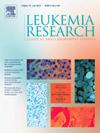Inter-modality variance of blast quantification in patients with myelodysplastic neoplasms (MDS) and its impact on risk stratification and overall survival
IF 2.1
4区 医学
Q3 HEMATOLOGY
引用次数: 0
Abstract
In the revised International Prognostic Scoring System (IPSS-R), blast enumeration by bone marrow cytology (BM-c) is crucial for risk stratification in myelodysplastic neoplasms (MDS), in the IPSS-Molecular (IPSS-M) however, incorporation of molecular data gained more prognostic impact. Blast count differences in the commonly used methods BM-c, flow cytometry (BM-f) and histology (BM-h) could possibly impact categorisation and overall survival (OS). In n = 145 investigated cases treated since 2012 in our institution, discordance in IPSS-R blast categories was found in 62/145 (43 %) of cases with evaluable blast counts in ≥ 2 methods. Discordant cases scored by BM-c showed either no change (24 %), a downgrade (48 %) or an upgrade (28 %) of their IPSS-R category when applying BM-f or BM-h. Discordant LR-MDS patients had significantly worse OS than concordant (72 vs 35 months, p = 0.031). In contrast, stratification by IPSS-M revealed no OS difference for discordant LR-MDS patients (p = 0.46). We could demonstrate that discordance occurred in almost half of patients, leading to re-stratification in a substantial amount of cases. Furthermore, OS was worse for discordant patients, but differences were ameliorated by inclusion of molecular data. This highlights the growing importance of molecular data over blast quantification in MDS.
骨髓增生异常肿瘤(MDS)患者细胞量化的模态间方差及其对风险分层和总生存的影响
在修订后的国际预后评分系统(IPSS-R)中,骨髓细胞学(BM-c)的细胞计数对骨髓增生异常肿瘤(MDS)的风险分层至关重要,然而在ipss -分子(IPSS-M)中,结合分子数据获得了更多的预后影响。在常用方法BM-c、流式细胞术(BM-f)和组织学(BM-h)中,母细胞计数的差异可能会影响分类和总生存期(OS)。在我院2012年以来收治的n = 145例调查病例中,≥ 2种方法可评估爆炸计数的病例中,有62/145(43 %)发现IPSS-R爆炸类别不一致。当应用BM-f或BM-h时,BM-c评分不一致的病例显示IPSS-R类别没有变化(24 %),降级(48 %)或升级(28 %)。不一致的LR-MDS患者的OS明显差于一致患者(72个月vs 35个月,p = 0.031)。相比之下,IPSS-M分层显示,不一致的LR-MDS患者的OS无差异(p = 0.46)。我们可以证明,几乎一半的患者发生了不一致,导致大量病例重新分层。此外,不一致患者的OS更差,但通过纳入分子数据改善了差异。这凸显了分子数据在MDS中比blast量化的重要性。
本文章由计算机程序翻译,如有差异,请以英文原文为准。
求助全文
约1分钟内获得全文
求助全文
来源期刊

Leukemia research
医学-血液学
CiteScore
4.00
自引率
3.70%
发文量
259
审稿时长
1 months
期刊介绍:
Leukemia Research an international journal which brings comprehensive and current information to all health care professionals involved in basic and applied clinical research in hematological malignancies. The editors encourage the submission of articles relevant to hematological malignancies. The Journal scope includes reporting studies of cellular and molecular biology, genetics, immunology, epidemiology, clinical evaluation, and therapy of these diseases.
 求助内容:
求助内容: 应助结果提醒方式:
应助结果提醒方式:


